Americans don’t benefit from ‘safety nets’ for farmers
Libertarians and small-government conservatives have myriad gripes with U.S. agricultural policy, but many would agree that it’s appropriate to provide a “safety net” for farmers. Arguments for government intervention include pointing to the role the farm economy has in national security and the conditions that make farmers uniquely vulnerable to natural disasters and droughts.
But whatever one thinks of the need for a farm “safety net,” it’s a misnomer to use that term to refer to the farm support system that actually exists. In practice, it works more like a rigged lottery system in which taxpayers always lose.
Consider our government-funded crop insurance program, which has served as the primary source of income support for farmers since the last farm bill. On average, the government picks up about 62 percent of the cost of farmers’ insurance premiums, regardless of the size of the farm operation. In theory, crop insurance premium support was intended to be a more market-friendly approach to help farmers manage risk, rather than providing direct payments to boost farm income, as we’d done in the past. But in a system where farm operations can purchase as much government-subsidized insurance as they please—with extravagant coverage options—the agriculture economy does not look much like a free market.
Look at what happened to farm income in 2012, when farmers experienced the worst drought in America in half a century. That year, nearly 1,700 counties across 36 states were declared natural disaster zones. Crop production across the country was devastated. But due to insurance claims and record-high crop prices, farmers did not suffer. Quite the contrary, farm income was at its most profitable level in history. According to a study by Iowa State University agriculture economist Bruce Babcock, crop insurance payouts for 2012 exceeded $16 billion, an almost 50 percent jump from the year before—and taxpayers bore 75 percent of the payouts.
You might think such a catastrophic drought justifies taxpayers stepping in to provide relief. That would be reasonable, but it’s hard to justify a so-called “safety net” that results in record-high incomes and pays out more than twice the estimated losses.
What’s more, recent evidence shows that taxpayers aren’t only on the hook for large payouts during drought years. On the other end of the spectrum, farmers this year are seeing record harvests. According to the most recent World Agricultural Supply and Demand Estimates report, U.S. corn, soybean and wheat crops are all headed for record yields. Wheat production is so high and prices so low that Sen. Jerry Moran, R-Kan., is asking the U.S. Department of Agriculture and the U.S. Agency for International Development to ship excess wheat to countries in need, in order to prop up prices in the United States. The circumstances couldn’t be much more different from 2012, but once again, farmers are expected to see extremely high insurance payouts.
How is this possible? Common sense may lead people to assume that if harvests are bountiful, farmers wouldn’t need as much support and payouts would be smaller. But that’s not the way our federal crop insurance program works. Farmers have the option to insure yields; when yields fall, as they did during the 2012 drought, farmers receive payouts at a price determined when they purchased the policy. But farmers also have the option to insure their revenues. When crop production is high, as it is now, prices go down and farmers may see their revenue fall. In this case, revenue protection kicks in to ensure that farmers earn their guaranteed revenue-per-acre.
These coverage options may sound like a sweet deal, but they aren’t even the most extravagant federal crop insurance product offered. Under another policy—known as the harvest price option—farmers are able cash out either the locked-in price at the time they planted or the current market price, whichever is higher. As R Street has written before, this is “the crop insurance equivalent of your auto insurer surprising you with a new Cadillac Escalade after you’ve totaled your Toyota Corolla.”
For taxpayers, the system looks like a damned-if-you-do, damned-if-you-don’t dilemma. Record drought: taxpayers lose. Record harvest: taxpayers lose. Since premium support is unlimited and farmers are likely to see net positive payouts either way, they will continue to purchase more and more subsidized crop insurance, putting taxpayers at greater risk.
It’s clear that reform is needed to rein in our ballooning crop programs and make them more accountable to taxpayers. Legislative reforms like those proposed in the Assisting Family Farmers through Insurance Reform Measures (AFFIRM) Act – introduced in 2015 in the House by Reps. Ron Kind, D-Wis., and Jim Sensenbrenner, R-Wis., and in the Senate by Sens. Jeff Flake, R-Ariz., and Jeanne Shaheen, D-N.H.—would go a long way toward putting reasonable restrictions on the program and making spending more predictable.
With the farm bill up for reauthorization in 2018 and deliberations poised to begin as early as the beginning of 2017, lawmakers will soon have an opportunity to enact reforms that reduce taxpayer liability and put a scope around our unsustainable farm-support system.
Reforms like these are the crucial first toward making our so-called “farm safety net” actually resemble a safety net.
Photo by Nomad_Soul / Shutterstock.com








